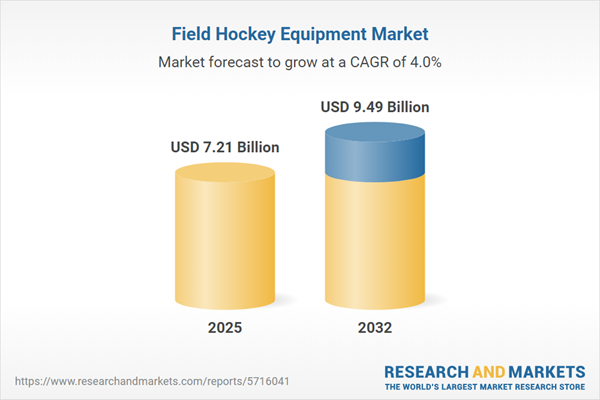Speak directly to the analyst to clarify any post sales queries you may have.
The global field hockey equipment market is in transition, driven by widespread digitalization, regulatory changes, and a rising commitment to sustainability. As executive leaders seek to adapt, the interplay of innovation and competitive agility is redefining how organizations secure supply resilience and operational effectiveness.
Market Snapshot: Field Hockey Equipment Market
The field hockey equipment market is currently experiencing steady growth, influenced by the swift integration of digital solutions and the advancement of intelligent manufacturing. Industry leaders turn to smart materials and connected processes to elevate product innovation, enhance operational efficiency, and deliver improved sourcing transparency. This market transformation is accelerating process optimization across the sporting goods landscape and enabling organizations to meet rapid shifts in demand and regulatory requirements. A strong emphasis on sustainability now shapes manufacturing decisions, with eco-conscious practices integral to product design, logistics, and compliance strategies. The competitive environment is evolving as new entrants and digital supply channels reshape procurement and distribution, challenging established brands and fostering higher responsiveness to end-user and regulatory expectations.
Scope & Market Segmentation
This report provides a comprehensive segmentation of the field hockey equipment sector, offering senior decision-makers authoritative guidance on aligning resources across technology, compliance, and sustainability priorities. Key segments are detailed to enable focused strategic planning and agile responses to shifting market dynamics.
- Equipment Types: Inclusive of apparel, grip tapes, bags, helmets, gloves, mouthguards, practice and foam balls, shin guards, and sticks (both composite and wood). Solutions are tailored to address the performance and safety standards needed for youth and adult users.
- Distribution Channels: Spanning specialty retailers, sporting goods chains, professional vendors, e-commerce platforms, and direct sales, each channel optimized for specific inventory management, buyer access, and market reach.
- Material: Both composite and wood options offer unique advantages in durability, performance, and cost-effectiveness, supporting procurement and product development targets for various user segments.
- End User: Addressing requirements for men, women, professionals, and amateurs, with attention to regulatory benchmarks and purpose-built safety features across play levels.
- Price Range: Encompassing high, mid, and low price tiers, including a detailed analysis of the 100–150 USD and 50–100 USD bands, to support buyer alignment and procurement strategy.
- Age Group: Differentiates product design for youth (under 12; 12–18) and adults (18–35; 36+), integrating ergonomic features and age-specific regulatory compliance to support targeted growth strategies.
- Geographies Covered: Targeted insights for the Americas, EMEA, and Asia-Pacific regions, with recommendations grounded in local business practices, cultural influences, and evolving regulatory landscapes.
- Company Developments: Profiles major industry players, including Grays International Ltd, Adidas AG, and Kookaburra International Pty Ltd, highlighting recent innovation and modernization efforts that are shaping future sector benchmarks.
Key Takeaways for Decision-Makers
- Digital tools and advanced manufacturing drive improved efficiency and transparency across supply chains, supporting informed procurement and B2B value advancement.
- Sustainable practices and ethical procurement bolster organizational reputation, laying the foundation for enduring strategic partnerships and risk mitigation.
- Omnichannel sales and adaptive inventory solutions increase responsiveness to evolving buyer preferences and enable flexible distribution management.
- Segmentation based on age, skill, and gender allows for highly relevant product offerings and unlocks growth opportunities across new and established user groups.
- Regional customization of approaches ensures compliance with local norms and supports regulatory achievements across multiple operational contexts.
- Cross-functional collaboration with athletes and sport professionals drives continuous product refinement, ensuring alignment with performance standards and shifting regulatory criteria.
Tariff Impact: Sourcing and Supply Chain Response
Recent U.S. import tariffs have compelled companies in the field hockey equipment sector to reconfigure sourcing and adapt distribution structures. This has strengthened regional alliances and revised supply models to maintain secure access to product lines, safeguard procurement dependability for bulk buyers, and sustain competitiveness amid evolving global trade protocols.
Methodology & Data Sources
This report utilizes executive interviews, stakeholder insights, site evaluations, and an examination of regulatory shifts. Supplementary industry data and market research ensure all recommendations are grounded in trusted, actionable intelligence for decision-makers in the field hockey equipment market.
Why This Report Matters
- Empowers senior leadership to anticipate changing trends and refine strategies under regulatory and market pressure.
- Guides resilient supply chain planning and the integration of digital solutions for agility in fluctuating conditions.
- Provides actionable, segment-specific guidance to foster sustained operational flexibility and regulatory alignment as requirements change.
Conclusion
With the insights from this report, field hockey sector executives can sharpen strategy, ensure supply chain resilience, and address shifting market demands to position their organizations for robust and sustainable growth.
Additional Product Information:
- Purchase of this report includes 1 year online access with quarterly updates.
- This report can be updated on request. Please contact our Customer Experience team using the Ask a Question widget on our website.
Table of Contents
3. Executive Summary
4. Market Overview
7. Cumulative Impact of Artificial Intelligence 2025
Companies Mentioned
The companies profiled in this Field Hockey Equipment market report include:- Grays International Ltd
- Adidas AG
- Kookaburra International Pty Ltd
- TK International Ltd
- STX, LLC
- Olaysport Ltd
- Mercian Hockey Ltd
- Harrow Sports Ltd
- Brabo Hockey BV
- OBO International Ltd
Table Information
| Report Attribute | Details |
|---|---|
| No. of Pages | 195 |
| Published | October 2025 |
| Forecast Period | 2025 - 2032 |
| Estimated Market Value ( USD | $ 7.21 Billion |
| Forecasted Market Value ( USD | $ 9.49 Billion |
| Compound Annual Growth Rate | 3.9% |
| Regions Covered | Global |
| No. of Companies Mentioned | 11 |









